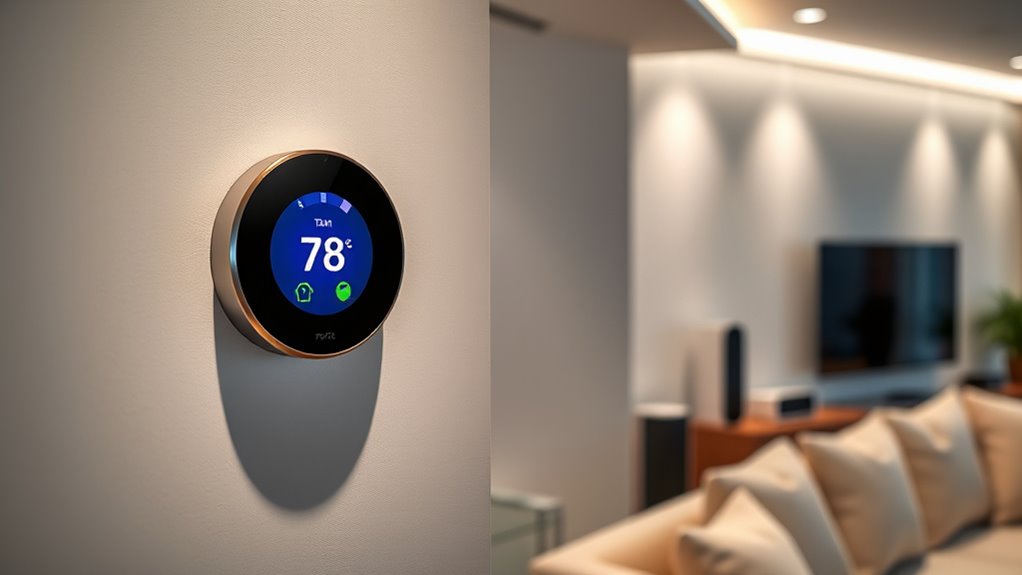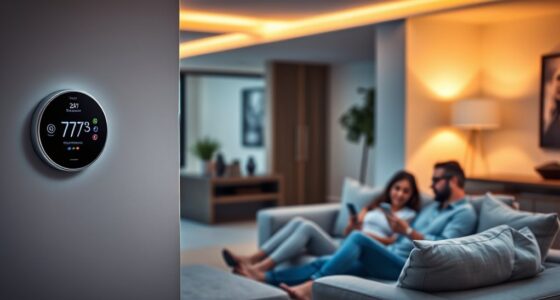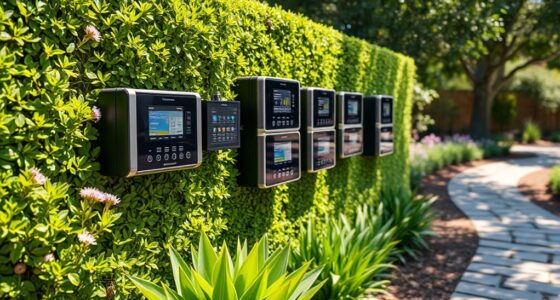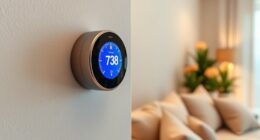If you’re searching for the best smart thermostats with voice control in 2025, I recommend models that support Alexa, Google Assistant, and Apple HomeKit, like the ecobee Smart Thermostat and Nest Thermostat. It’s vital to take into account compatibility with your HVAC system, ease of installation, and energy-saving features. Many models offer sleek touchscreens, customizable schedules, and remote access. Keep in mind that some need a C-wire for power. To find out which fits your home best, simply continue exploring your options.
Key Takeaways
- Compatibility with major voice assistants like Alexa, Google Assistant, and SmartThings ensures seamless hands-free control.
- User-friendly interfaces and customizable schedules enhance ease of use and smart home integration.
- Support for energy-saving features and smart sensors optimize comfort and reduce utility costs.
- Easy installation options, app setup, and connectivity reliability are crucial for a smooth smart thermostat experience.
- Advanced features like geolocation, auto modes, and remote access provide smarter, more efficient home climate management.
ecobee Smart Thermostat Premium with Sensor and Air Quality Monitor

If you’re looking to cut energy costs while maintaining ideal comfort, the ecobee Smart Thermostat Premium is a smart choice, especially since it helps reduce heating and cooling expenses by up to 26% annually. It features a built-in air quality monitor that alerts you to poor indoor air conditions and reminds you when it’s time to change filters. The included SmartSensor adjusts temperature in key rooms, preventing hot or cold spots. With geofencing, it detects occupancy and automatically pauses your HVAC system when doors or windows stay open, saving energy. Its advanced algorithm optimizes temperature based on outdoor conditions, ensuring comfort and efficiency all year round.
Best For: homeowners seeking to reduce energy costs and improve indoor air quality with a smart, customizable thermostat that integrates seamlessly with various smart home systems.
Pros:
- Helps cut heating and cooling costs by up to 26% annually, earning ENERGY STAR certification.
- Built-in air quality monitor and SmartSensor enhance comfort and air health throughout the home.
- Compatible with multiple voice assistants and smart home platforms for versatile control.
Cons:
- Installation can be complex and may require professional assistance, especially for wiring and sensor placement.
- Setup instructions for sensors and accessories can be unclear, leading to potential frustration.
- Customer support experiences vary, with some users finding assistance less helpful.
ecobee Smart Thermostat Enhanced, Programmable WiFi Thermostat
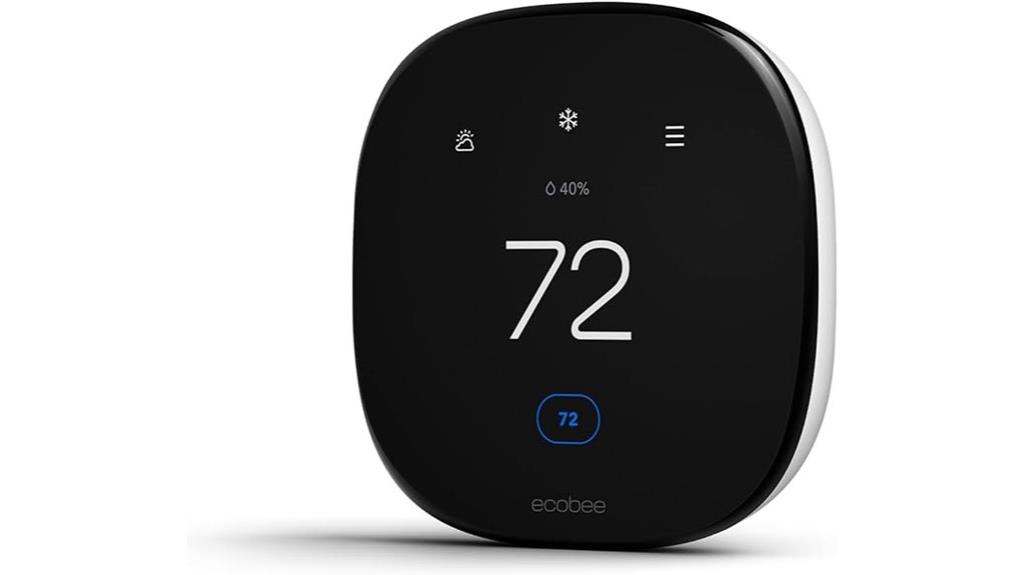
The ecobee Smart Thermostat Enhanced stands out as an ideal choice for homeowners seeking advanced energy management combined with seamless smart home integration. It automatically adjusts temperatures based on occupancy, schedules, and optimization, saving up to 26% annually. Compatible with most 24 VAC HVAC systems, it supports smart sensors for room-specific control and humidity management. The sleek, wall-mounted design features a responsive LCD touchscreen and easy app control via iOS and Android. With smart platform integrations like Alexa, Apple HomeKit, and Google Assistant, it offers effortless voice and remote control. Its energy-saving features and user-friendly setup make it a versatile, efficient upgrade for any smart home.
Best For: homeowners seeking an energy-efficient, smart, and customizable thermostat that integrates seamlessly with various smart home platforms and HVAC systems.
Pros:
- Automates temperature adjustments for optimal comfort and energy savings, reducing costs by up to 26% annually.
- Supports integration with popular smart home platforms like Alexa, Apple HomeKit, and Google Assistant, enabling voice and remote control.
- Features a sleek, user-friendly touchscreen interface and easy app setup for effortless control and scheduling.
Cons:
- Installation can be complex, especially for homes without a C-wire; professional wiring assistance may be necessary.
- Some users report product malfunctions and limited customer support, leading to concerns about long-term reliability.
- Compatibility depends on the HVAC system; pre-installation inspection is recommended to ensure proper functioning.
meross Smart WiFi Thermostat with Matter, Alexa, Apple Home & Google Assistant

For those seeking a budget-friendly yet feature-rich smart thermostat, the meross Smart WiFi Thermostat with Matter, Alexa, Apple Home, and Google Assistant stands out as an excellent choice. It fits 95% of HVAC systems, supports local integration via Matter, and works with major platforms like Apple HomeKit, Alexa, and Google Assistant. With simple installation—especially if wiring is compatible—you can control and schedule your home’s temperature remotely through the app. Its sleek, square design features a clear LED display and supports automation, energy savings, and voice commands. Despite some setup challenges, most users find it reliable, easy to use, and a cost-effective way to smarten your home.
Best For: those looking for an affordable, easy-to-install smart thermostat compatible with most HVAC systems and major smart home platforms.
Pros:
- Supports a wide range of smart home integrations including Matter, Apple HomeKit, Alexa, and Google Assistant
- User-friendly app with scheduling, remote control, and energy-saving features
- Sleek, compact design with clear LED display and straightforward installation process
Cons:
- Requires a C-wire for proper installation; some users may need an adapter if wiring is incompatible
- Limited compatibility with electric baseboard heaters
- Occasional connectivity issues reported on mobile apps and delays in thermostat response
ecobee Smart Thermostat Essential with Wi-Fi and Voice Assistant Compatibility

The ecobee Smart Thermostat Essential stands out as an excellent choice for homeowners seeking a compact, energy-efficient device that integrates seamlessly with popular voice assistants like Siri, Alexa, and Google Assistant. Its sleek, round design features an LCD touchpad and wall-mount, making installation straightforward. This Energy Star Certified thermostat controls cooling, fan, and compatible HVAC systems, saving up to 23% on energy bills. Battery-powered and Wi-Fi enabled, it offers remote management via a user-friendly app. While it’s simple to set up, some users note limitations such as single scheduling and basic features. Overall, it’s a reliable, efficient option for smart home enthusiasts.
Best For: homeowners seeking a compact, energy-efficient smart thermostat with easy installation and voice assistant compatibility.
Pros:
- Seamless integration with Siri, Alexa, and Google Assistant for voice control
- Energy-saving features that can reduce bills by up to 23%
- User-friendly app for remote management and scheduling
Cons:
- Limited scheduling options, such as lack of multi-season or multi-zone scheduling
- Basic feature set with no advanced customization or multi-zone communication
- Some users experience initial setup issues or Wi-Fi connectivity challenges
Google Nest Thermostat, Programmable Wi-Fi Smart Thermostat
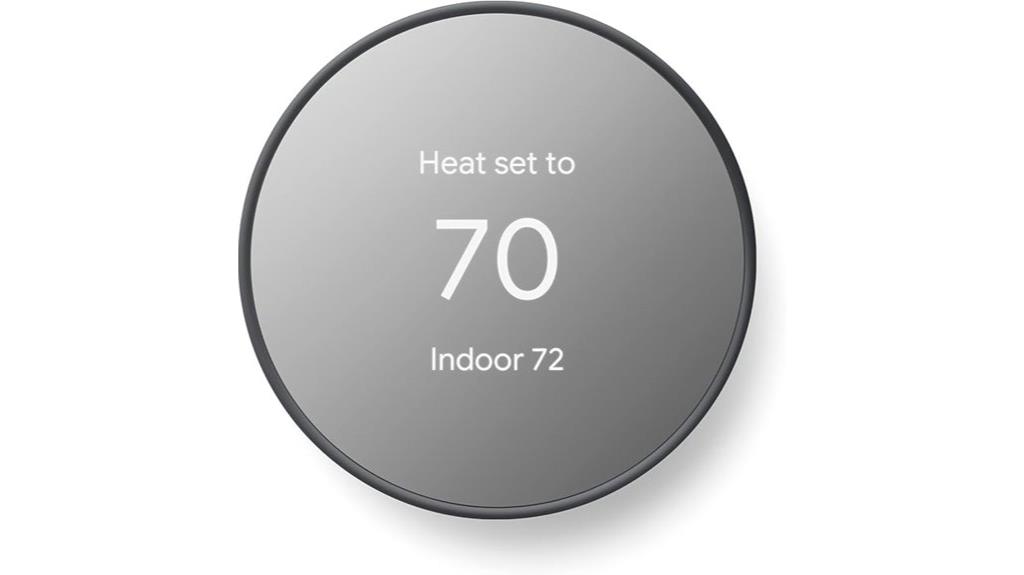
If you’re looking to boost your home’s energy efficiency with minimal effort, the Google Nest Thermostat offers an intuitive and smart solution. It’s ENERGY STAR certified, helping you save energy without sacrificing comfort. Compatible with various HVAC systems, it’s easy to install—usually in under 30 minutes—and works without a C-wire in most homes. You can control it remotely via the Google Home app or through voice commands with Google Assistant and Alexa. It learns your habits over time, optimizing heating and cooling. With features like energy monitoring, alerts, and integration with utility programs, it’s a reliable, cost-effective choice for smarter home climate control.
Best For: homeowners seeking an easy-to-install, energy-efficient smart thermostat that offers remote control and compatibility with multiple HVAC systems.
Pros:
- User-friendly installation process typically completed in under 30 minutes
- Supports remote control via the Google Home app and voice commands with Google Assistant and Alexa
- Helps reduce energy bills through automatic adjustments and energy monitoring features
Cons:
- Lacks a built-in lock feature for controlling access
- May require a power accessory or adapter kit if a C-wire is not present
- Occasional connectivity or wiring compatibility issues can arise during setup
Amazon Smart Thermostat

Looking to upgrade your home heating and cooling with a sleek, energy-efficient smart thermostat? The Amazon Smart Thermostat is a great choice. It supports most 24V HVAC systems, including force air, heat pumps, and radiant boilers, but not electric baseboard heat. Made with Honeywell technology, it’s ENERGY STAR certified, helping you save on energy bills. Installation is quick with the Alexa app, and it connects via Wi-Fi for remote control. While it lacks a built-in microphone, you can control it with Alexa-enabled devices. Overall, it’s an affordable, reliable option that enhances energy management and integrates seamlessly with your smart home.
Best For: homeowners seeking an energy-efficient, easy-to-install smart thermostat compatible with most 24V HVAC systems and integrated with Alexa for remote control.
Pros:
- Supports a wide range of 24V HVAC systems, including heat pumps and radiant boilers.
- ENERGY STAR certified, helping to reduce energy bills and promote sustainability.
- Simple installation process via the Alexa app with a sleek, user-friendly interface.
Cons:
- Not compatible with 110-240V systems like electric baseboard heat.
- Some users experience delays or malfunctions with HVAC control or app crashes.
- Lacks a built-in microphone; voice control requires an Alexa-enabled device.
Sensi Smart Thermostat
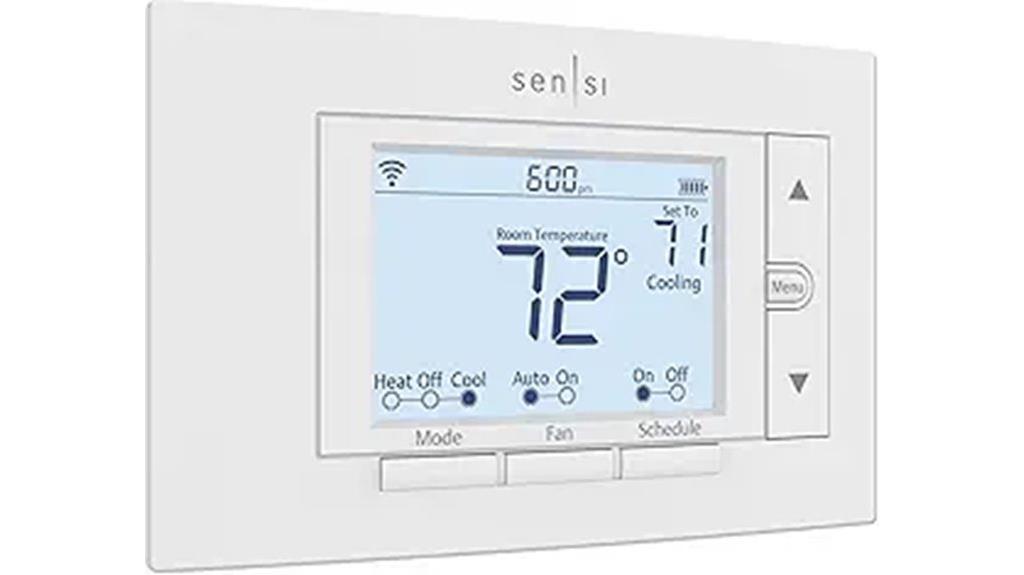
Are you seeking a smart thermostat that combines ease of installation with reliable voice control? The Sensi Smart Thermostat (model ST55) from Emerson is a top choice. It’s Wi-Fi enabled and compatible with most HVAC systems, including boilers and heat pumps. No common wire needed for most setups, making installation straightforward. It supports voice commands via Alexa, Google Assistant, and others, plus manual controls. Certified Energy Star, it reduces energy use by about 23%. Its sleek design fits standard wall spaces, and the user-friendly app simplifies setup and management. Overall, Sensi offers a reliable, energy-efficient solution for those wanting smart comfort with easy installation.
Best For: those seeking an energy-efficient, easy-to-install smart thermostat with reliable voice control and compatibility with a variety of HVAC systems.
Pros:
- Easy DIY installation with step-by-step app guidance and no common wire needed in most cases
- Compatible with major voice assistants like Alexa and Google Assistant for hands-free control
- Certified Energy Star helps reduce HVAC energy consumption by approximately 23%
Cons:
- Limited detailed energy usage reports and analytics
- Some users experience minor delays in setting adjustments or app responsiveness
- Does not support Bixby voice commands or advanced energy monitoring features
Schluter Ditra-Heat-E-RS1 Smart Thermostat with Floor Sensors
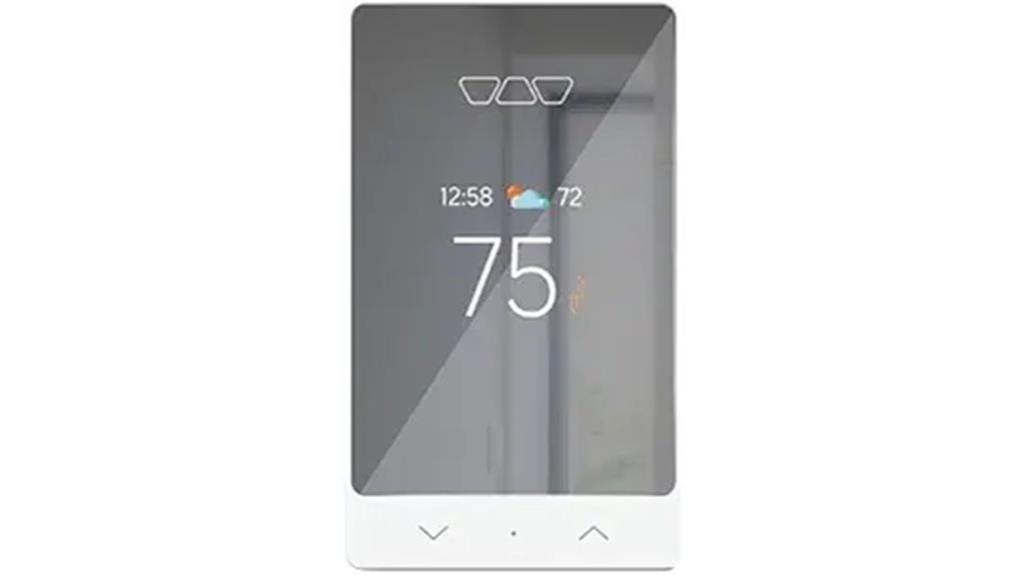
The Schluter Ditra-Heat-E-RS1 Smart Thermostat with Floor Sensors stands out as an ideal choice for homeowners seeking precise control over their heated floors with modern convenience. Its sleek design features a mirror-finish LCD display and backlit touchpad, offering easy control through app, voice, or touch. Compatible with Alexa and Google Home, it supports dual sensors, energy tracking, and geo-location automation. Setup is quick, and the device provides reliable scheduling and safety features like GFCI protection. Although the mirror finish can be hard to read in bright light, its smart functionalities make it a high-quality, stylish solution for managing floor heat effortlessly.
Best For: homeowners seeking a stylish, smart-controlled floor heating thermostat with precise scheduling and energy management features.
Pros:
- Modern, sleek mirror-finish LCD display with backlit touchpad for easy control
- Compatible with Alexa and Google Home for seamless voice and app integration
- Supports dual sensors, energy tracking, and safety features like GFCI protection
Cons:
- Mirror finish can be difficult to read in bright lighting conditions
- Some users experience challenges with Apple HomeKit configuration
- Higher price point may be a concern for budget-conscious buyers
Sensi Lite Smart Thermostat
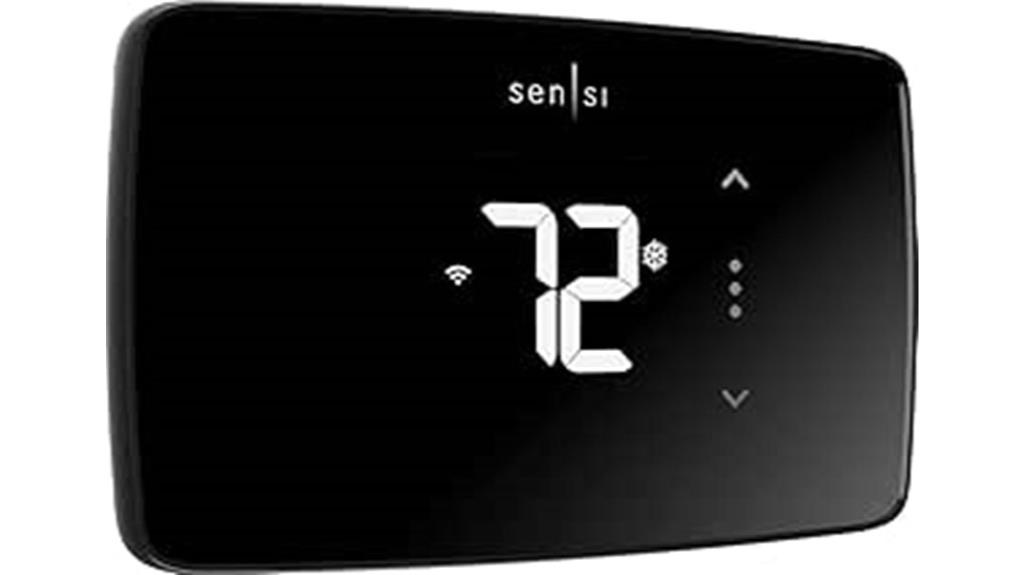
If you want an easy-to-install smart thermostat that offers reliable voice control and energy savings, the Sensi Lite Smart Thermostat is an excellent choice. It features Wi-Fi connectivity, an LCD display, and simple wall-mounting, making setup straightforward. Compatible with Alexa, Google Assistant, and SmartThings, you can control it via your smartphone or voice commands. It helps save around 23% on HVAC costs through scheduling and geofencing. Certified by Energy Star, it also guarantees energy efficiency. Most systems don’t require a C-wire, and the device suits basic to moderate HVAC setups. Overall, it’s a reliable, user-friendly option for smarter home climate control.
Best For: homeowners seeking an easy-to-install, energy-efficient smart thermostat compatible with popular voice assistants and basic to moderate HVAC systems.
Pros:
- Simple DIY installation with clear instructions and included hardware
- Compatible with Alexa, Google Assistant, and SmartThings for voice control
- Helps save approximately 23% on HVAC energy costs through scheduling and geofencing
Cons:
- Occasional connectivity issues after battery replacement or Wi-Fi drops, especially in rural areas
- May require external transformers for certain heat pump systems lacking W2 connection
- Limited advanced features; mainly suited for basic to moderate HVAC setups
Vine Smart Thermostat with Touchscreen Display
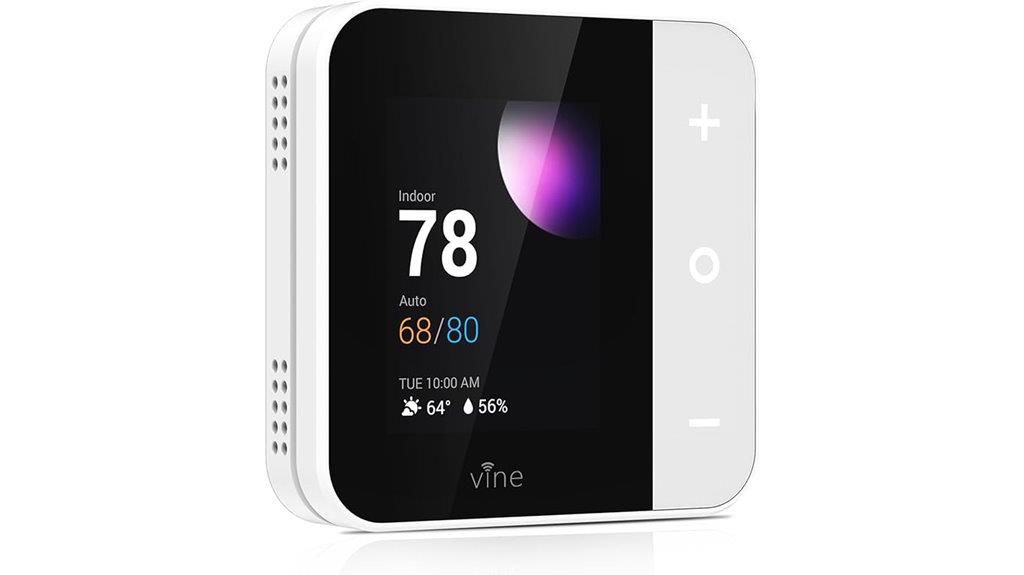
The Vine Smart Thermostat with Touchscreen Display is an excellent choice for homeowners who want a modern, user-friendly way to control their heating and cooling systems. It’s compatible with most systems, including conventional, heat pump, electric, gas, oil, and dual fuel setups, and installs easily in about 20 minutes with online guides. You can control and monitor it remotely via the Vine or Smart Life App, plus use voice commands with Alexa or Google Assistant. Its 2.8-inch color touchscreen offers intuitive navigation, programmable schedules, auto Home/Away modes, and handy alerts, making it a smart, convenient addition to any home.
Best For: homeowners seeking a versatile, easy-to-install smart thermostat that offers remote control, programmable scheduling, and voice command compatibility.
Pros:
- Compatible with a wide range of heating and cooling systems, including conventional, heat pump, electric, and dual fuel setups
- Easy 20-minute installation with comprehensive online guides and videos
- Features a user-friendly 2.8-inch touchscreen display with customizable schedules and auto Home/Away modes
Cons:
- Requires a common wire (C-Wire) for installation, which may not be available in all homes
- Limited to 8 periods per day in the programmable schedule, which might be restrictive for some users
- May have compatibility issues with certain proprietary or less common HVAC systems
Smart Thermostat with Voice Control and Touchscreen

A smart thermostat with voice control and a touchscreen is ideal for homeowners seeking effortless climate management combined with modern convenience. It features an LCD display, touchscreen interface, and supports flexible weekly programming, including six temperature settings per day. Compatible with Amazon Alexa and other voice assistants, it allows hands-free control. The device includes safety features like child lock, low-temperature, and anti-frozen functions, making it suitable for electric and water heating systems. Easy to install with embedded design, it combines precise temperature sensing with user-friendly operation, offering a seamless way to optimize comfort and energy savings in your home.
Best For: homeowners seeking an easy-to-use, customizable, and energy-efficient thermostat compatible with voice assistants and modern smart home setups.
Pros:
- Supports extensive weekly programming with multiple temperature settings per day for tailored comfort.
- Compatible with Amazon Alexa and other voice assistants for hands-free control.
- Features child lock, low-temperature, and anti-frozen safety functions for enhanced safety and reliability.
Cons:
- Requires proper wiring and embedded installation, which may be challenging for DIY setups.
- Limited to a temperature range of 5-70°C, which may not suit all climate needs.
- The device’s size and design may not fit all interior aesthetics or existing wall setups.
SunTouch SunStat ConnectPlus Wi-Fi Thermostat with Touchscreen and Voice Control

For homeowners seeking a seamless smart heating experience, the SunTouch SunStat ConnectPlus stands out with its advanced voice control compatibility. Designed for electric floor heating, it offers remote Wi-Fi access, a sleek 4.3-inch touchscreen, and voice commands with Alexa and Google Assistant. Its intuitive interface supports floor and air sensing, customizable schedules, energy monitoring, and weather adjustments. SmartStart technology guarantees floors are warm at scheduled times, enhancing comfort and efficiency. Easy to install and compatible with existing sensors, this thermostat provides reliable control, remote monitoring, and notifications. It’s an excellent choice for those wanting modern, voice-enabled control over their heating systems.
Best For: homeowners seeking a modern, voice-enabled smart thermostat for electric floor heating with remote monitoring and easy installation.
Pros:
- Intuitive 4.3-inch touchscreen with easy navigation and modern design
- Compatible with Alexa and Google Assistant for voice control
- Supports remote Wi-Fi access, energy monitoring, and weather-based adjustments
Cons:
- Limited programming options with only three periods per day
- Installation videos and visual guides are somewhat limited
- Slight difficulty in separating the screen from the base during setup
Vine Programmable WiFi Thermostat with Touch Screen

If you want a user-friendly thermostat that combines modern design with festive flair, the Vine Programmable WiFi Thermostat with Touch Screen is an excellent choice. Its high-resolution 4.0-inch color touchscreen makes it easy to read and operate, with automatic brightness adjustments and holiday-themed themes for occasions like Christmas and Valentine’s Day. You can control and monitor it remotely using the Vine or Smart Life App, and it works seamlessly with Alexa and Google Home for voice commands. With 7-day scheduling, auto home/away modes, and energy-saving features, it offers both convenience and efficiency. Easy to install, it’s compatible with most 24V AC systems, requiring only a C-wire.
Best For: Homeowners seeking a modern, user-friendly WiFi thermostat with festive features, energy efficiency, and remote control capabilities.
Pros:
- High-resolution 4.0-inch color touchscreen for easy readability and operation
- Compatible with Alexa and Google Home for voice control and remote management via mobile apps
- 7-day programmable schedules with auto home/away modes for energy savings and convenience
Cons:
- Requires a C-wire for installation, which may not be available in all systems
- Compatibility limited to 24V AC systems, excluding some modern or specialized HVAC setups
- Installation may still require some technical knowledge or professional assistance for optimal setup
Honeywell Home Wi-Fi Programmable Touch Screen Thermostat

The Honeywell Home Wi-Fi Programmable Touch Screen Thermostat stands out as an ideal choice for homeowners seeking an intuitive, customizable control center for their HVAC systems. Its high-definition color touchscreen is easy to navigate, with customizable backgrounds and real-time displays of indoor/outdoor temperatures, humidity, and weather forecasts. Supporting flexible scheduling and utility peak rate management, it learns your preferences using Honeywell’s Smart Response technology. Compatible with Alexa, Google Assistant, and other smart home platforms, it allows voice control and remote management. ENERGY STAR certified, it promotes energy savings, offers energy-tracking tips, and supports utility demand response programs for cost efficiency.
Best For: homeowners seeking an easy-to-use, customizable, and energy-efficient smart thermostat with remote control and voice assistant integration.
Pros:
- High-definition color touchscreen with customizable backgrounds for a personalized look
- Supports flexible scheduling, energy savings tips, and utility demand response programs
- Compatible with Alexa, Google Assistant, and other smart home platforms for voice control and remote management
Cons:
- Requires a C-wire for installation; may not be compatible with all HVAC systems, especially electric baseboard heating
- Some users report touchscreen responsiveness issues or system short cycling if wiring/configuration isn’t correct
- Durability and build quality concerns noted by a few users over time
Programmable Smart Thermostat for Electric Heating
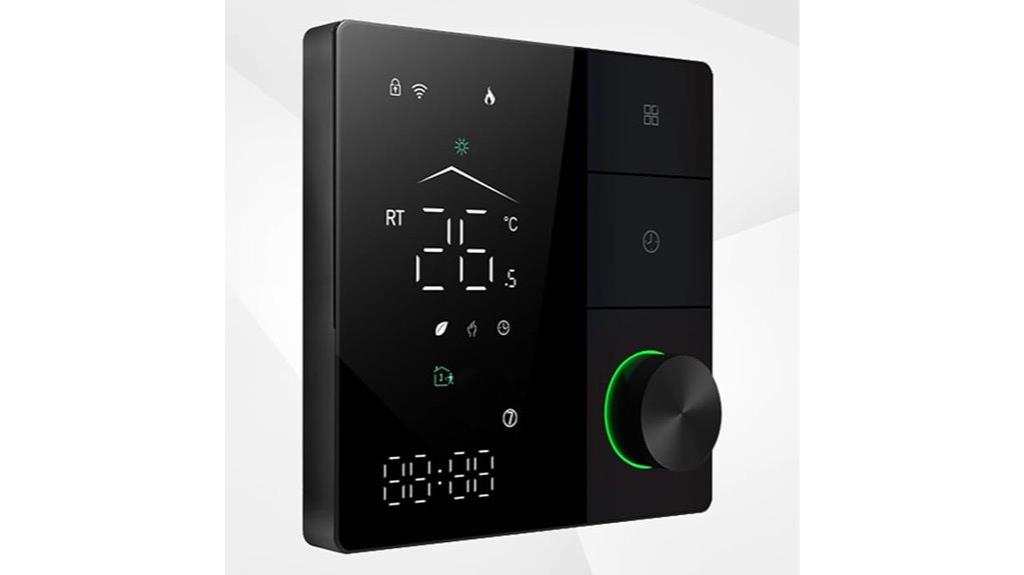
A programmable smart thermostat for electric heating is an excellent choice for homeowners seeking precise control and energy savings. Designed specifically for electric systems, it supports 95-240V and 16A load capacity, making it compatible with floor heating, baseboards, radiators, and oil heaters. It features an LED touchscreen, app control, and voice commands, supporting Matter, Apple HomeKit, Alexa, and Google Assistant. With 7-day programmable schedules, child lock, weather updates, and remote access, it offers both convenience and efficiency—saving around 35% on energy costs. Easy to install with clear instructions, it’s perfect for creating a smarter, eco-friendly home.
Best For: homeowners seeking precise, energy-efficient control of electric heating systems with smart connectivity and easy DIY installation.
Pros:
- Supports multiple control methods including app, voice, and touch for versatile operation.
- Compatible with major smart home platforms like Matter, Apple HomeKit, Alexa, and Google Assistant.
- Offers customizable 7-day programmable schedules and energy savings of approximately 35%.
Cons:
- Limited to electric heating systems within the specified voltage and load range.
- May require a junction box converter for certain installation setups.
- As a smart device, it relies on Wi-Fi connectivity, which may affect remote access if network issues occur.
Factors to Consider When Choosing a Smart Thermostat With Voice Control
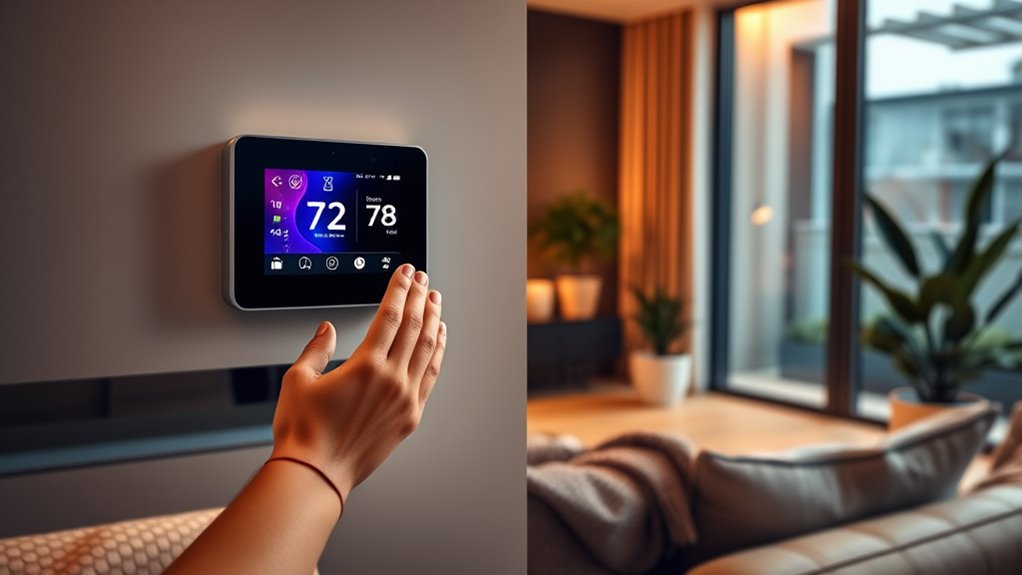
When choosing a smart thermostat with voice control, I focus on how well it functions with my existing HVAC system and which voice assistants it supports. I also consider how easy it is to install, along with features that help save energy and cut costs. Finally, I look at the user interface to verify it’s simple and intuitive to use.
Compatibility With HVAC Systems
Choosing a smart thermostat with voice control requires verifying it’s compatible with your existing HVAC system. First, check your system’s voltage—most residential systems use 24V, but some electric baseboard heaters might need higher voltages. Determine if your system needs a C-wire, as many smart thermostats rely on it for consistent power, especially in heat pump or multi-stage setups. Confirm the thermostat supports your specific configuration, whether it’s single-stage, multi-stage, heat pump, or boiler. Also, verify compatibility with your control protocols, like Wi-Fi, Zigbee, or Z-Wave, to ensure seamless connectivity. Finally, review the manufacturer’s specifications to see if your HVAC system type and features are explicitly supported. This step helps prevent setup issues and guarantees maximum performance.
Voice Assistant Integration
Ever wondered how smoothly your smart thermostat responds to your voice commands? The key is ensuring it’s compatible with your preferred voice assistant, like Alexa, Google Assistant, or Siri. Check if it supports core functions—adjusting temperature, changing modes, and setting schedules—so you can control everything effortlessly. Some thermostats have built-in microphones, while others need an external speaker or hub for voice recognition; consider what’s best for your setup. Voice command responsiveness matters, especially in noisy environments or when multiple people are involved. Also, look for advanced features like scene activation, multi-room control, and automation routines. These integrations make your smart home more seamless and intuitive, allowing you to get the most out of your voice-controlled thermostat.
Ease of Installation
Installing a smart thermostat with voice control can be straightforward, but it’s important to take into account several key factors to guarantee a smooth setup. Many models require wiring inspections or professional installation, especially if your system lacks a C-wire, to verify compatibility and proper functioning. Luckily, some thermostats include step-by-step app guides and video tutorials that make DIY installation easier. Compatibility with your HVAC system, like heat pumps or multi-stage setups, can also affect the complexity, so verifying this beforehand is vital. Features like quick-attach mounting plates and color-coded wire labels help speed up installation and reduce errors. Overall, the ease of setup depends on clear instructions, available wiring, and whether additional accessories are needed.
Energy Saving Features
When selecting a smart thermostat with voice control, focusing on energy-saving features can make a significant difference in reducing your utility bills. Look for models with auto-away and occupancy detection, which adjust temperatures when no one’s home, preventing unnecessary energy use. Energy-saving algorithms that learn your schedule and preferences help optimize heating and cooling, minimizing waste. Support for smart sensors in different rooms ensures precise temperature control, avoiding overcooling or overheating. Compatibility with utility demand response programs allows your thermostat to participate in energy-saving incentives during peak periods. Additionally, clear energy reports and usage analytics enable you to monitor your consumption habits and make adjustments to maximize savings over time. These features are essential for an efficient, cost-effective smart thermostat.
User Interface Design
Choosing a smart thermostat with voice control becomes much easier when its user interface is intuitive and straightforward. A clear menu system and recognizable icons make it simple to navigate, even for those new to smart devices. A responsive touchscreen with customizable display options allows quick adjustments and personalized control, enhancing convenience. Visual indicators like status lights or progress bars give immediate feedback on system status, reducing confusion. An effective design minimizes the steps needed to set schedules, switch modes, or access voice features, saving time and effort. Consistent, legible text and simple navigation paths help prevent errors and boost confidence in using the device. Overall, a well-designed interface ensures a seamless, user-friendly experience that complements the voice control functionality.
Connectivity Options
Selecting a smart thermostat with voice control hinges on its connectivity options, which determine how reliably and seamlessly it integrates into your smart home system. Look for support for Wi-Fi, Bluetooth, Zigbee, or Z-Wave protocols, as these guarantee stable communication with your devices. Compatibility with voice assistants like Amazon Alexa, Google Assistant, Apple Siri, or Samsung Bixby is essential for smooth voice commands. Also, check if it relies on local voice control or cloud-based processing; local control offers faster responses and better privacy. Make sure it works with your preferred smart home platforms such as Apple HomeKit, SmartThings, or IFTTT to enable more automation possibilities. These connectivity features directly impact how convenient and effective your voice-controlled thermostat will be.
Scheduling Flexibility
A smart thermostat’s scheduling flexibility is essential for matching your daily routines and maximizing energy savings. I look for models that support multiple schedules, like 5+2 or 6+1, to adapt to varied days. Being able to set different temperatures for specific times or days helps personalize comfort and cut costs. Features like auto-away or auto-home modes automatically adjust settings based on occupancy, boosting efficiency. Voice control integration enhances scheduling by letting me quickly override or tweak settings through simple commands. Additionally, an intuitive app or device interface makes it easy to modify schedules without hassle or technical skills. Overall, flexible scheduling ensures my home stays comfortable while optimizing energy use effortlessly.
Support and Warranty
When evaluating smart thermostats with voice control, it’s crucial to take into account the support and warranty options. I look for products that offer at least 1-3 years of warranty to protect against defects and malfunctions. It’s also important that the manufacturer provides responsive customer support through multiple channels like phone, email, or live chat. I review user feedback to ensure the support team is helpful and reliable. Additionally, I check if the warranty covers both hardware and software issues, including firmware updates and app connectivity problems. Finally, I value extensive documentation, troubleshooting guides, and access to online resources, which help me resolve issues quickly and keep my system running smoothly. Good support and warranty give me peace of mind with my investment.
Frequently Asked Questions
How Do Smart Thermostats Integrate With Existing Home Automation Systems?
Smart thermostats easily integrate with existing home automation systems by connecting through Wi-Fi or Bluetooth, allowing seamless control via apps or voice commands. I simply link them to my smart hub or platform like Alexa, Google Home, or Apple HomeKit. This setup lets me automate temperature adjustments based on my routines, making my home’s climate more comfortable and energy-efficient without any complicated wiring or setups.
What Are the Privacy Implications of Voice-Controlled Thermostat Devices?
Oh, the irony of trusting our cozy homes to devices that listen in. Voice-controlled thermostats collect data to personalize comfort, but that means potential privacy breaches. I worry about my conversations being stored or shared without my knowledge. While convenience is tempting, I remain cautious. It’s essential to read privacy policies and choose devices that prioritize security, so I can enjoy a smarter home without sacrificing my privacy.
Can Smart Thermostats Learn and Adapt to User Behavior Over Time?
Absolutely, smart thermostats can learn and adapt to my behavior over time. They track my routines, adjusting temperatures automatically for comfort and efficiency. I appreciate how they become more intuitive, saving energy and money. While they do analyze data to improve, I always stay aware of privacy settings. Overall, this adaptability makes my home’s climate control smarter, more personalized, and easier to manage daily.
Are Voice Commands Effective in Noisy Household Environments?
Imagine trying to turn down the heat during a lively family gathering — voice commands can sometimes get lost in the noise. In noisy households, voice commands may be less effective, especially if background chatter or appliances interfere. I’ve found that in such environments, using a smart thermostat’s app or integrating with a smart speaker’s noise-canceling features can improve responsiveness, ensuring your commands are understood regardless of household activity.
How Do Smart Thermostats Handle Firmware Updates and Security Patches?
When it comes to firmware updates and security patches, I’ve found smart thermostats handle them seamlessly. They usually download updates automatically when connected to Wi-Fi, ensuring my device stays secure and functions efficiently. I appreciate that these updates often happen quietly in the background, so I don’t have to worry about manual installations. It’s reassuring to know my thermostat stays protected with the latest security measures without any extra effort on my part.
Conclusion
Choosing the right smart thermostat is like finding the perfect key to open your home‘s comfort. With so many options boasting voice control and smart features, you can tailor your space effortlessly. Whether you prefer ecobee’s sensors or Google’s sleek design, the right device makes your home smarter and your life easier. So go ahead, pick one—your ideal climate is just a voice command away, ready to turn your house into a haven.
